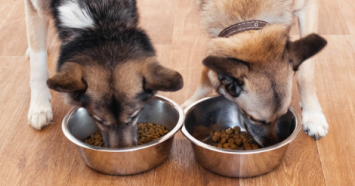
Food aggression in dogs is usually more common in dogs who have had to go without regular meals at some point, but it’s more common others than you may realize. Almost all dogs have a limit to how much they’re willing to let even their favorite person bother their food or take their favorite treat away. Food aggression toward other dogs or people can be troublesome – but have no fear. Food aggression is quite easily managed, and most dogs can have their food guarding issues resolved.
What is food aggression?
Food aggression is a type of resource guarding when a dog protects their food to an inappropriate degree. Their aggression can be dangerous to people near the dog at feeding time and can result in dogs fighting over food. Some dogs aren’t food aggressive until high value treats or wet food is present, while others stand guard even over dry kibble.
Mild food aggression signs include when a dog stiffens or eats faster when someone comes close while they eat. They may hover over the bowl in a tense posture. In more severe cases, a dog may growl or even bite. Pay attention to your dog’s body language to understand what they’re telling you.
Food aggression triggers include:
Rawhides
Antlers
Chews
Treats
Anything your dog shows a special interest in
Kids often think that bones or rawhides make good toys for playing fetch, but a child could be hurt because the dog thinks their treat is being taken away. An unsuspecting cat might get bitten because they wandered too close to the dog. Give your dog a safe place where they can eat or enjoy high value treats without being disturbed, and pick them up when your dog is finished with them.
How to Manage Food Aggression in Dogs
You may not know that your dog is food aggressive until you get another pet – after all, you haven’t been sniffing around your dog's food bowl during mealtime. Begin managing food aggression while training your dog. Here are a few helpful tips:
Feed your dog in their crate or alone in a room with the door closed. Make sure they have plenty of time to eat
Avoid bowl sharing & disturbing your dog during mealtime
How to Stop Food Aggression in Dogs
The funny part about dog food aggression training techniques is that you reward food guarding with more food. Safely practice reward-based training with your dog to help curb food aggression.
1. Feed your dog in their normal quiet spot.
2. Enter their space and, before they growl or show signs of guarding, throw a high value treat (hot dog slices are my dog’s fav) into or near their bowl. This gives your dog a positive association with people being near them at feeding time.
3. Practice this treat throwing trick regularly, but get a bit closer each time. If you can, allow other people to start throwing treats too.
Hopefully, you’ll see your dog relaxing and maybe even being happy when you come around during mealtime.
Once your dog seems quite relaxed during mealtimes, ask them to “sit” for their high-value treat. It’s good to get the whole family involved, including children if you feel comfortable. The goal is to help your dog understand that humans, no matter the size, want no part of their dinner.
Food aggression is a very manageable and treatable behavioral issue. Be safe, set your dog up for success, and you can work through their problem together.